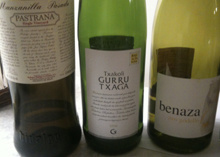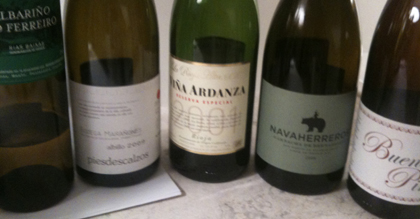Txakoli, albarino, Manzanilla and more! A Spanish tasting
 A group of friends that know each other through their sons’ school has a tasting every so often. I’ve been fortunate enough to lead the smart and fun group in about ten tastings over the past couple of years. Our most recent tasting explored the exciting category of Spain beyond the fruit bomb, focusing on indigenous grapes, values, and/or off-the-beaten-path regions.
A group of friends that know each other through their sons’ school has a tasting every so often. I’ve been fortunate enough to lead the smart and fun group in about ten tastings over the past couple of years. Our most recent tasting explored the exciting category of Spain beyond the fruit bomb, focusing on indigenous grapes, values, and/or off-the-beaten-path regions.
We started with a manzanilla pasada, Pastrana vineyard, from Hidalgo La Gitana ($28). Sherry gets a bad rap and usually conjures up images of men in tweed sport coats with elbow patches sitting in leather-bound dens. But this sherry–and other manzanillas–is a kind of transformative sherry, one that changes your opinion of a whole category of drinks. I anticipated that about half the people would like it; instead, everyone really liked it. The sea-breeze, iodine character with faint oxidation yet freshness (odd combination to fathom, but it was there) really got the evening off to a great start. Pairing with marcona almonds was ideal. As we moved to the table, we had an incredible feast of Mediterranean (mostly Turkish, actually) delights.
Next we had an invigorating white txakoli, the Gurrutxaga 2010 ($19). The faint fizz and the snap of acidity made this also unanimously praised. We followed this with Do Ferreiro, an exceptional Albarino 2009 ($23) from Rias Baixas that we have discussed previously and it too was unanimously praised. Yay, three for three so far!
Then we encountered our first disappointment of the night. I poured the good value godello from Benaza ($13) in all the glasses and as our hostess smelled it, she wondered aloud if there wasn’t something a little bit wrong with it. Alas, it was corked. Encountering a corked wine is always a disappointment but in this case it was a teachable moment! People always love to know what a corked wine is so that they can send a wine back at a restaurant with brio, panache, and certainty.
We finished off the whites with Bodegas Maranones’ Picarana blanco 2009 ($20), an Albillo from Madrid of all places. The grapes aren’t grown in the Plaza del Sol, mind you, but in the surrounding area outside the capital. This wine saw some time in large barrels and was the fullest-bodied, highest-alcohol white in our lineup.
Our oldest wine of the tasting was the La Rioja Alta 2001, Vina Ardanza Reserva Especial. This wine is not made every year and for $33 it’s a great value that the winery aged for you for a decade. The group liked the wine a lot.
We concluded with a duo of grenaches/garnachas. Returning again to the Madrid region, the Bernabeleva 2008 Navaherreros Tinto ($22), which impressed the group with its light color but full flavors. Sadly, the Buena Pinta 2009 ($22) from Manchuela was also corked. But at least someone from the group nailed it again!
Even though 25% of the wines were plagued by TCA, it was still a fun evening.
One final note: the eight wines came from six different importers, I think. There are so many importers (such as De Maison, Jose Pastor, Rare Wine Co and Louis/Dressner to name a few) bringing in fun wines from the small estates of Spain.
Search for these wines at retail





On June 23rd, 2011 at 9:46 am ,adi wrote:
Thanks for sharing. Albarino and La Rioja Alta are definitely personal favorites!
On June 23rd, 2011 at 10:10 am ,Joe wrote:
I’m yet to see Txakoli in the Atlanta market. I’m sure it’s got to be somewhere. For now, I will get by with Vinho Verde to quench in the oppressive Georgia heat.
On June 23rd, 2011 at 11:45 am ,Dave Erickson wrote:
Wow, great lineup! I’d get a replacement bottle of the Benaza right quick. It is a fine example of what can be done with godello, and it’s priced right. Another great spritzy summer wine is aVinYó “Vi D’Agulla,” made by a producer best known for his cavas. It is light, bright, dry, full of mineral character, and made from 100% Muscat Blanc à Petits Grains (Yeah, it’s Muscat. No, it’s not even remotely sweet.)
On June 23rd, 2011 at 11:46 am ,Scott R wrote:
Dr. Vino,
The Sherry you wrote about is actually produced by Hidalgo La Gitana. Pastrana is the name of the vineyard from which the grapes hail. Additionally, the wine is technically a Manzanilla Pasada, as opposed to a Manzanilla. Manzanilla Pasadas are aged longer in Solera than typical Manzanillas.
On June 23rd, 2011 at 12:00 pm ,Dr. Vino wrote:
Adi – glad you like those ones!
Joe – Try to find a txakoli this summer at least once this summer if you can!
Dave – Thanks for the thumbs up!
Scott – true and corrected above. Do you like that sherry?
On June 23rd, 2011 at 10:02 pm ,Scott R wrote:
Dr. Vino,
I have enjoyed it in the past, but it is certainly an anomaly being a single vineyard Sherry. There’s almost no ground for comparison as there exist few, if any, other single vineyard expression of the appellation. Add to this the uniqueness of the Manzanilla Pasada designation and you have a distinctive, singular wine.
Interestingly, Lustau just released a Manzanilla Amontillada (how it’s actually spelled) from an almacenista. I have yet to taste it, but look forward to it since I’ve never tried such an uncommon sub-category of Sherry.
When you view these esoteric imports in the context that Gonzalez Byass also enjoyed great success with it’s limited release of Tio Pepe En Rama in the UK, maybe it’s fair to say that Sherry is on the upswing, long overdue, but certainly welcome.
On June 24th, 2011 at 2:14 am ,Vitabella Wine Daily Gossip – Luxury Wine – Marketing Strategy – Today Vega Sicilia Prepares for Better Times. Also read about Echo Falls, Blossom Hill, Kumala, Hardy's, Spiegelau, Parker, Bollywood, Ridgeview, Lafite wrote:
[…] ahead… (Drinks Media Wire) Red alert for Spain’s lesser wine regions (Liverpool Echo) New Zealand Wines Best Lafite (WSJ) Buying guide: Bordeaux-style red blends in South Africa (Wine Mag) Value in the small print […]
On June 24th, 2011 at 11:09 am ,Dr. Vino wrote:
Scott – Thanks for your comments. I will have to try some of those you mention.
On January 2nd, 2012 at 7:59 am ,nancy todd wrote:
Wine still only 2 euros a glass here in Spain including La Rioja. I am very spoiled.